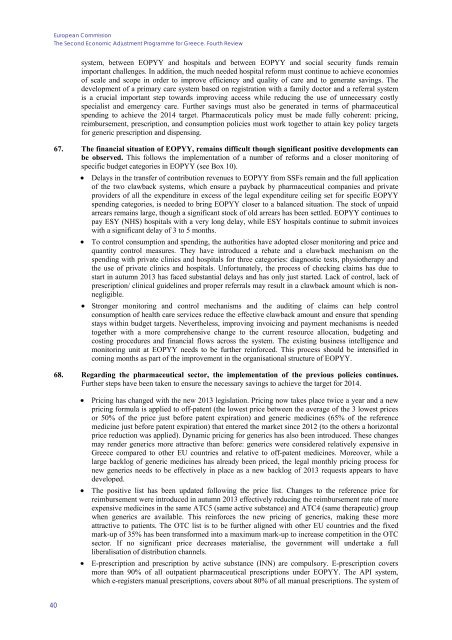ocp192_en
ocp192_en
ocp192_en
Create successful ePaper yourself
Turn your PDF publications into a flip-book with our unique Google optimized e-Paper software.
European CommissionThe Second Economic Adjustm<strong>en</strong>t Programme for Greece. Fourth Reviewsystem, betwe<strong>en</strong> EOPYY and hospitals and betwe<strong>en</strong> EOPYY and social security funds remainimportant chall<strong>en</strong>ges. In addition, the much needed hospital reform must continue to achieve economiesof scale and scope in order to improve effici<strong>en</strong>cy and quality of care and to g<strong>en</strong>erate savings. Thedevelopm<strong>en</strong>t of a primary care system based on registration with a family doctor and a referral systemis a crucial important step towards improving access while reducing the use of unnecessary costlyspecialist and emerg<strong>en</strong>cy care. Further savings must also be g<strong>en</strong>erated in terms of pharmaceuticalsp<strong>en</strong>ding to achieve the 2014 target. Pharmaceuticals policy must be made fully coher<strong>en</strong>t: pricing,reimbursem<strong>en</strong>t, prescription, and consumption policies must work together to attain key policy targetsfor g<strong>en</strong>eric prescription and disp<strong>en</strong>sing.67. The financial situation of EOPYY, remains difficult though significant positive developm<strong>en</strong>ts canbe observed. This follows the implem<strong>en</strong>tation of a number of reforms and a closer monitoring ofspecific budget categories in EOPYY (see Box 10).• Delays in the transfer of contribution rev<strong>en</strong>ues to EOPYY from SSFs remain and the full applicationof the two clawback systems, which <strong>en</strong>sure a payback by pharmaceutical companies and privateproviders of all the exp<strong>en</strong>diture in excess of the legal exp<strong>en</strong>diture ceiling set for specific EOPYYsp<strong>en</strong>ding categories, is needed to bring EOPYY closer to a balanced situation. The stock of unpaidarrears remains large, though a significant stock of old arrears has be<strong>en</strong> settled. EOPYY continues topay ESY (NHS) hospitals with a very long delay, while ESY hospitals continue to submit invoiceswith a significant delay of 3 to 5 months.• To control consumption and sp<strong>en</strong>ding, the authorities have adopted closer monitoring and price andquantity control measures. They have introduced a rebate and a clawback mechanism on thesp<strong>en</strong>ding with private clinics and hospitals for three categories: diagnostic tests, physiotherapy andthe use of private clinics and hospitals. Unfortunately, the process of checking claims has due tostart in autumn 2013 has faced substantial delays and has only just started. Lack of control, lack ofprescription/ clinical guidelines and proper referrals may result in a clawback amount which is nonnegligible.• Stronger monitoring and control mechanisms and the auditing of claims can help controlconsumption of health care services reduce the effective clawback amount and <strong>en</strong>sure that sp<strong>en</strong>dingstays within budget targets. Nevertheless, improving invoicing and paym<strong>en</strong>t mechanisms is neededtogether with a more compreh<strong>en</strong>sive change to the curr<strong>en</strong>t resource allocation, budgeting andcosting procedures and financial flows across the system. The existing business intellig<strong>en</strong>ce andmonitoring unit at EOPYY needs to be further reinforced. This process should be int<strong>en</strong>sified incoming months as part of the improvem<strong>en</strong>t in the organisational structure of EOPYY.68. Regarding the pharmaceutical sector, the implem<strong>en</strong>tation of the previous policies continues.Further steps have be<strong>en</strong> tak<strong>en</strong> to <strong>en</strong>sure the necessary savings to achieve the target for 2014.• Pricing has changed with the new 2013 legislation. Pricing now takes place twice a year and a newpricing formula is applied to off-pat<strong>en</strong>t (the lowest price betwe<strong>en</strong> the average of the 3 lowest pricesor 50% of the price just before pat<strong>en</strong>t expiration) and g<strong>en</strong>eric medicines (65% of the refer<strong>en</strong>cemedicine just before pat<strong>en</strong>t expiration) that <strong>en</strong>tered the market since 2012 (to the others a horizontalprice reduction was applied). Dynamic pricing for g<strong>en</strong>erics has also be<strong>en</strong> introduced. These changesmay r<strong>en</strong>der g<strong>en</strong>erics more attractive than before: g<strong>en</strong>erics were considered relatively exp<strong>en</strong>sive inGreece compared to other EU countries and relative to off-pat<strong>en</strong>t medicines. Moreover, while alarge backlog of g<strong>en</strong>eric medicines has already be<strong>en</strong> priced, the legal monthly pricing process fornew g<strong>en</strong>erics needs to be effectively in place as a new backlog of 2013 requests appears to havedeveloped.• The positive list has be<strong>en</strong> updated following the price list. Changes to the refer<strong>en</strong>ce price forreimbursem<strong>en</strong>t were introduced in autumn 2013 effectively reducing the reimbursem<strong>en</strong>t rate of moreexp<strong>en</strong>sive medicines in the same ATC5 (same active substance) and ATC4 (same therapeutic) groupwh<strong>en</strong> g<strong>en</strong>erics are available. This reinforces the new pricing of g<strong>en</strong>erics, making these moreattractive to pati<strong>en</strong>ts. The OTC list is to be further aligned with other EU countries and the fixedmark-up of 35% has be<strong>en</strong> transformed into a maximum mark-up to increase competition in the OTCsector. If no significant price decreases materialise, the governm<strong>en</strong>t will undertake a fullliberalisation of distribution channels.• E-prescription and prescription by active substance (INN) are compulsory. E-prescription coversmore than 90% of all outpati<strong>en</strong>t pharmaceutical prescriptions under EOPYY. The API system,which e-registers manual prescriptions, covers about 80% of all manual prescriptions. The system of40


